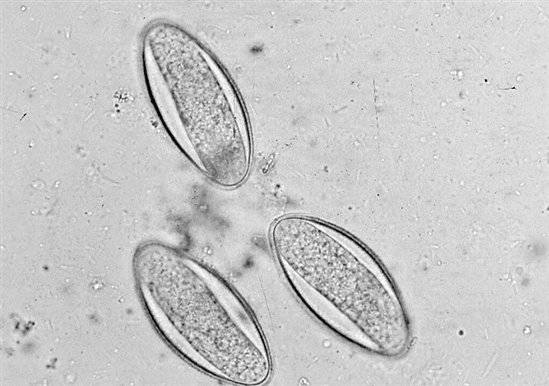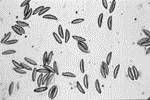Pinworms are nematode parasites (Family Oxyuridae) which have simple, direct life cycles and are frequent contaminants of both specific pathogen-free (SPF) and conventional colonies of laboratory mice. Pinworms are transmitted through ingestion of embryonated eggs. Two species of pinworms that commonly infect laboratory mice are Syphacia obvelata and Aspiculuris tetraptera.
Animals may be infected with both species concurrently. The prevalence of pinworms in an infected rodent population depends on many factors, including environmental load, gender, age, strain and immune status. Males tend to have higher parasite burdens than females, while young animals tend to have higher worm burdens than older animals. Laboratory mice tend to be more resistant to experimentally induced infection than wild mice. Athymic mice, as might be expected, have an increased susceptibility to infection.
Syphacia spp. reside in the cecum or anterior colon, where they feed on bacteria present in the lumen. The females migrate to the anus and lay their adhesive-coated eggs directly on the perianal skin. Syphacia spp. eggs become infective 5-20 hours after release. S. obvelata has a prepatent period (time from ingestion of infective larvae to production of eggs by mature worms) of 11-15 days. Syphacia spp. may embryonate on the host and retroinfect the animal by migrating back into the body.
Aspiculuris tetraptera larvae reside in the Crypts of Lieberkuhn in the proximal colon, after hatching in the cecum. Unlike Syphacia spp., A. tetraptera migrate from the proximal to distal colon to deposit eggs. The eggs are then excreted in the feces and are not infective until 5-8 days later. A. tetraptera has a 21-25 day prepatent period.
Unlike many common diseases of laboratory mice, pinworm infections can be treated
Infections with pinworms are generally considered to be mildly pathogenic or non-pathogenic in animals with normal immune systems. However, pinworm infection may interfere with research goals in a number of ways. Pinworm infection has been shown to increase the host humoral immune response to nonparasitic antigenic stimuli and accelerate the development of the hepatic monooxygenase system. In athymic mice, pinworm infection may instigate the development of a lymphoproliferative disorder that eventually leads to lymphoma.
Unlike many common diseases of laboratory mice, pinworm infections can be treated. A rederivation program is worth some consideration especially if other pathogens are present in the colony and the colony can be maintained at a high health status post-rederivation. Pinworms are treated with anthelmintic compounds.
Treatment programs may include ivermectin, administered topically or in drinking water, or treatment with feed milled to contain fenbendazole. Anthelmintics are not entirely benign compounds, however, and side effects of treatment, especially with ivermectin, may occur.
Pinworm eggs are usually considered to be persistent environmental contaminants, and stringent sanitation measures are often undertaken to rid animal rooms of eggs. Many of these measures are instituted based on characteristics of the human pinworm, Enterobius vermicularis, which has been intensively studied as a representative of the Oxyuridae. Few reports directly document the presence of rodent Oxyurid eggs in the environment, but thorough cleaning of the animal room environment is rarely a bad idea, although it may be expensive and time-consuming.
Figure 1. Fecal float showing ova of Aspiculuris tetraptera.

Figure 2. Tape test showing numerous Syphacia obvelata ova.

References
(authors in bold are Jackson Laboratory scientists)
Pritchett K and Johnston N. A review of treatments for the eradication of pinworm infections from laboratory rodent colonies. Contemp. Top. Lab. Anim. Sci 2002; 41:31-41.
[PMID:11958602]